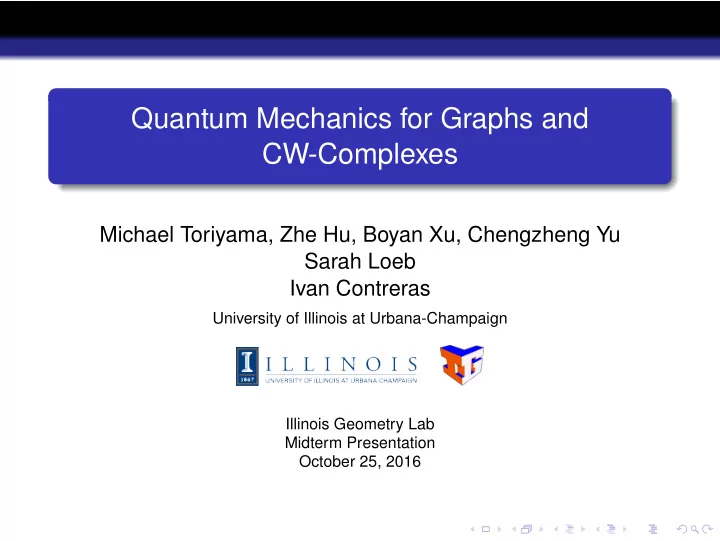

Quantum Mechanics for Graphs and CW-Complexes Michael Toriyama, Zhe Hu, Boyan Xu, Chengzheng Yu Sarah Loeb Ivan Contreras University of Illinois at Urbana-Champaign Illinois Geometry Lab Midterm Presentation October 25, 2016
Quantum Mechanics for Graphs and CW complexes This project develops a version of the Schr¨ odinger model of quantum mechanics for graphs and CW complexes to solve combinatorial problems compute topological invariants model phenomena in information theory and materials sciences.
Schr¨ odinger equation for graphs We use a discretization of the Schr¨ odinger equation from “usual” quantum mechanics which takes the form i ∂ ∂ t Ψ t = − ∆Ψ t and is solved by the exponential exp ( i ∆ t )Ψ 0 . This partition function is typically easy to compute and encodes certain topological and combinatorial data of the graph.
Graph Laplacian Definition The adjacency matrix A Γ of a graph Γ is given by � 1 i ∼ j A ( i , j ) = 0 otherwise and graph Laplacian ∆ Γ val ( i ) i = j ∆ Γ ( i , j ) = − 1 i ∼ j 0 otherwise
Example Given a graph Γ 1 2 3 4 0 1 0 0 1 − 1 0 0 1 0 1 1 − 1 3 − 1 − 1 A Γ = and ∆ Γ = 0 1 0 1 0 − 1 2 − 1 0 1 1 0 0 − 1 − 1 2
Result on “new paths” Theorem For a graph Γ � ∆ k Γ ( i , j ) = sgn ( γ ) | γ i → j | = k where the sum is taken over “new paths” γ i → j of length k starting from vertex i and ending at j.
Application to topology We can use the Laplacian ∆ to calculate Betti numbers of graphs b 0 = dim ( ker (∆)) b 1 = dim ( coker (∆)) 2 2 3 1 1 1 4 4 2 3 3
Evolution of quantum states The Schr¨ odinger operator in QM is - ∆ + u(x) We use u(x)=0. Solve the ODE: ∂φ ∂ t = − ∆ φ 6 3 5 7 4
Atomistic simulation Heat Diffusion in Gallium
Recommend
More recommend